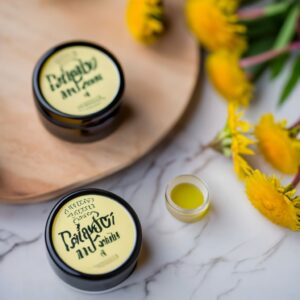
As the vibrant yellow dandelions start to bloom, they not only signify the arrival of spring but also offer a multitude of skincare benefits. Dandelions, often mistaken as weeds, are packed with nutrients from flower to root, making them an excellent ingredient for soothing and moisturizing dry and cracked skin. In this comprehensive guide, we will explore how to make dandelion salve and lip balm using simple ingredients that you may already have at home. These natural skincare products can help alleviate sore muscles, joint pain, and provide much-needed hydration for your skin.
Harvesting Dandelions: A Responsible Approach
Before we delve into the process of making dandelion salve and , let’s talk about the importance of foraging dandelions. It’s essential to collect dandelion blossoms on a dry sunny day when the flower heads are fully opened. Avoid areas near roadways and ensure the places you collect them from are free from chemicals and pesticides. While gathering the blossoms, carefully remove any insects or small ants without washing the petals. The yellow dandelion petals are not only sweet and tasty but also a crucial ingredient in our dandelion salve.
Preparing Dandelions for Use
Fresh dandelions contain a significant amount of moisture, which can affect the consistency of the oil used in the salve. To avoid this, you can wilt the dandelion blossoms overnight by spreading them on a paper towel or homemade drying screens. For those who prefer extra caution, allowing them to dry completely over several days, depending on the weather, is recommended.
Dandelion Oil Recipe

The key ingredient in our dandelion salve is the dandelion-infused oil, which can be easily prepared using the traditional method of infusion. Here’s how you can make it:
- Take a pint-sized jar and fill it halfway with dried or wilted dandelion blossoms.
- Pour a carrier oil of your choice, such as olive oil, coconut oil, almond oil, or primrose oil, into the jar, filling it almost to the top.
- Cover the jar with a lid and place it in a dark spot.
- Shake the jar occasionally over the course of two weeks.
- After two weeks, strain the oil using cheesecloth to obtain a high-quality, golden dandelion-infused oil.
dandelion salve

Dandelion salve is a herbal balm made from dandelion flowers infused into oil and mixed with beeswax. It’s used topically for various skin conditions like dryness, cuts, bruises, and insect bites. Dandelion’s natural compounds may offer anti-inflammatory and skin-soothing effects. However, those allergic to plants like daisies or ragweed should use with caution.
Dandelion Salve Recipe

how to make dandelion salve
Ingredients:
- 1 cup dandelion-infused oil (made by steeping dandelion flowers in a carrier oil like olive or coconut oil)
- 1/4 cup beeswax pellets or grated beeswax
- Optional: a few drops of essential oil (such as lavender or tea tree) for fragrance and added benefits
Instructions:
- Prepare the dandelion-infused oil by filling a clean glass jar with dried dandelion flowers and covering them with the carrier oil. Seal the jar tightly and let it sit in a sunny spot for 2-4 weeks, shaking it occasionally to mix the ingredients.
- Once the oil is infused, strain out the dandelion flowers using a fine mesh strainer or cheesecloth, and pour the infused oil into a clean, dry saucepan.
- Add the beeswax pellets to the saucepan with the infused oil.
- Heat the mixture over low heat, stirring constantly until the beeswax is completely melted and the mixture is well combined.
- Optional: If desired, add a few drops of essential oil for fragrance and additional benefits. Stir to combine.
- Carefully pour the mixture into clean, dry containers, such as small jars or tins.
- Let the salve cool and solidify at room temperature before sealing the containers with lids.
Your homemade dandelion salve is now ready to use! Simply apply it topically to dry or irritated skin as needed.
dandelion salve benefits
Dandelion salve offers a range of benefits for the skin due to its nourishing and healing properties. Here are some key advantages:
- Anti-inflammatory properties: Dandelion possesses anti-inflammatory properties that can help ease stiffness in muscles and joints, making it ideal for relieving sore muscles or achy arthritic joints.
- Moisturizing and soothing: This natural salve provides intense hydration, making it effective in soothing cracked, chapped hands, feet, elbows, and knees.
- Anti-aging effects: Dandelions are rich in antioxidants, which can reduce the signs of aging and promote the generation of healthy skin cells.
- Healing properties: Dandelion salve can help heal cuts, burns, and minor skin irritations, including insect bites.
dandelion salve uses

Dandelion salve can be used for various purposes, including:
- Moisturizing Dry Skin: Apply dandelion salve to areas of dry skin to hydrate and soften the skin.
- Healing Minor Cuts and Scrapes: The soothing properties of dandelion salve can help promote the healing of minor cuts, scrapes, and scratches.
- Relieving Insect Bites and Stings: Dandelion salve may provide relief from itching and irritation caused by insect bites and stings.
- Soothing Sunburn: Apply dandelion salve to sunburned skin to help soothe inflammation and promote healing.
- Reducing Skin Inflammation: The anti-inflammatory properties of dandelion salve may help reduce redness, swelling, and irritation associated with various skin conditions.
- Easing Muscle and Joint Pain: Massaging dandelion salve into sore muscles or achy joints may help alleviate pain and discomfort.
- Promoting Healthy Skin: Regular use of dandelion salve can help maintain healthy skin by providing essential nutrients and antioxidants.
- Protecting Skin Barrier: Dandelion salve forms a protective barrier on the skin, helping to prevent moisture loss and environmental damage.
Overall, dandelion salve is a versatile natural remedy that can be used to support skin health and address various minor skin issues.
Conclusion
Harnessing the natural benefits of dandelions, you can create your own dandelion salve and dandelion oil to nourish and heal your dry skin. By foraging dandelions, drying the petals, and infusing them into oil, you can easily prepare the key ingredient for these skincare products. Whether you’re looking to soothe sore muscles, moisturize cracked skin, or simply enjoy the therapeutic properties of dandelions, this guide has provided you with all the necessary steps and information. Embrace the power of nature and indulge in the soothing and moisturizing effects of dandelion-infused salve and dandelion oil for healthy, glowing skin.
faq’s
What is dandelion oil, and how is it different from dandelion salve?
- Dandelion oil is an infusion made by steeping dandelion flowers in a carrier oil like olive or coconut oil. It’s primarily used as a base ingredient for various skincare products. Dandelion salve, on the other hand, is made by combining dandelion-infused oil with beeswax and other ingredients to create a balm-like consistency that can be applied topically for skin benefits.
What are the benefits of dandelion oil and dandelion salve for the skin?
- Both dandelion oil and salve are rich in nutrients and antioxidants that can help soothe and moisturize the skin. They may also have anti-inflammatory properties, making them beneficial for conditions like dry skin, minor cuts and scrapes, insect bites, and sunburns. Additionally, dandelion salve may provide relief for sore muscles and joint pain when massaged into the affected areas.
How can I make dandelion oil at home?
- To make dandelion oil, fill a clean glass jar with dried dandelion flowers and cover them with a carrier oil. Seal the jar and let it sit in a sunny spot for several weeks to allow the flowers to infuse into the oil. Afterward, strain out the flowers, and the infused oil is ready for use.
What ingredients do I need to make dandelion salve?
- The main ingredients for dandelion salve include dandelion-infused oil, beeswax (to thicken the salve), and optional essential oils for fragrance and additional benefits.
How do I prepare dandelions for making oil and salve?
- When harvesting dandelions, choose fully opened flower heads on a dry, sunny day. Avoid areas near roadsides and ensure the flowers are free from chemicals and pesticides. Carefully remove any insects without washing the petals. To dry the dandelions, wilt them overnight on a paper towel or drying screen.
Are there any precautions or contraindications when using dandelion oil or salve?
- While dandelion oil and salve are generally safe for topical use, individuals with allergies to plants in the Asteraceae family (such as daisies, marigolds, or ragweed) should use caution. It’s also advisable to perform a patch test before applying to larger areas of the skin, especially for those with sensitive skin.
How long does dandelion oil and salve last?
- When stored in a cool, dark place, dandelion oil and salve can last for several months to a year. However, it’s always a good idea to check for any signs of rancidity or spoilage before use.
